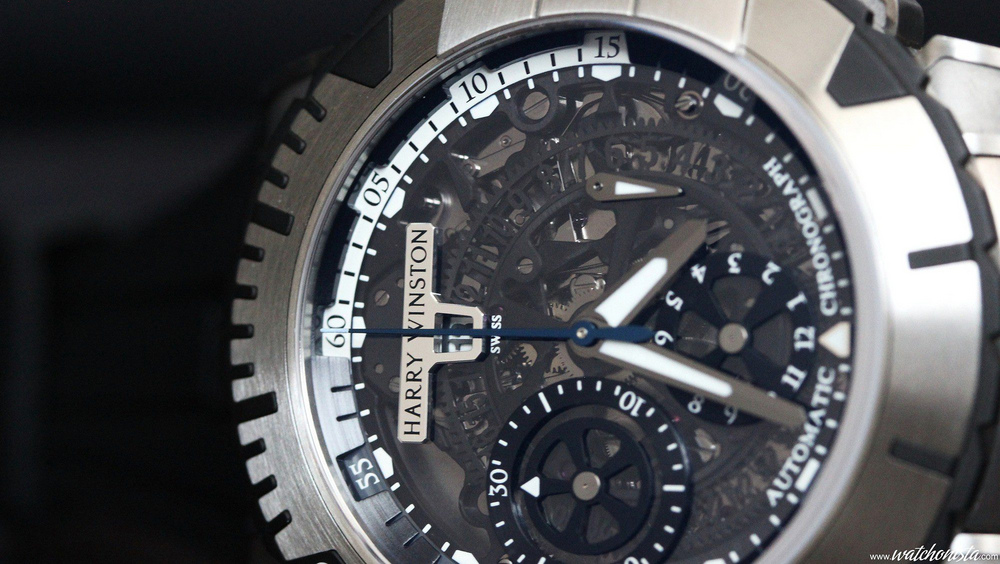The Fusion concept was one of the 2000's horologic bubble's stylistic drivers.
It was initiated by Hublot and much of the watchmaking industry followed suit. Yet, for many brands, "Fusion" merely meant "superimposition", superimposition of materials, of styles, of complications….
In order to well understand what "Fusion" stands for, one ideally has to have some culture in science fiction, to be familiar with the SF and Cyberpunk literature, with Lang's Metropolis, with these urban, cold, technological and tough universes. Harry Winston's design department has obviously grasped these aesthetic codes quite well.
Indeed, the brand officially presented the Ocean Sport Chronograph at Baselworld. This watch is definitely part of the Fusion trend.
In fact, this high-tech “toolwatch” is a case study in successful cross-trending. If it was a car, one would call it a crossover.
But if one had to draw a comparison with the automotive world, the piece would borrow more from a BMW X6 than from a Pontiac Vibe….
A "Horologic crossover", why?

Prior to wearing the watch, one notices that it is quite bulky, as much because of its 44mm as because of its wide directional bezel (the watch is waterproof up to 200m). But the watch’s cutting-edge look gives way to luxury; as soon as one wears it, one is surprised by the piece's weightlessness and comfort, and one could think it is made of titanium.
But after careful scrutiny under the sunlight, the reflections are different, as different as those seen on white gold vs. platinum. Furthermore, this case's metal ages differently from titanium…
This metal is Zalium, an alloy of zirconium (chemically close to titanium) and aluminium, patented by Harry Winston; this material stems from some cutting-edge alloys utilized in the aerospace industry.
This high-tech material makes perfect sense with the watch's super-technical look and the mix of brushed metal and of PVD coated inserts.

The watch develops its entire flavor when one carefully examines the dial: under certain angles, it merely seems to be a polished black surface; but under other angles, a magnificent blackened ruthenium skeleton shows up.
In fact, the only part of the movement based on an ETA 28-92 that is skeletonized is the exclusive Harry Winston's chronograph plate. This module directly sits on the 28-92, in order to maximize the contrasts; the dial is covered by a slightly smoked crystal, which makes the watch look stealthier.
The Ocean Sport series' very angular case, is fitted with the perfect dial: skeletonized, dark and technical. The sprawling skeleton seems to spread upon the bezel, through the black PVD coated inserts.

To go on with the process of putting some Cyber into the classic watchmaking codes, the dial features a date aperture at 12 o'clock, which is almost surprising, since it is split by the chronograph second-hand.
To get an optimal legibility, one has to start the chronograph, very playful; Harry Winston should have pushed the envelope further, by proposing a wider chronograph hand in order to completely conceal the date.
Finally, despite their super-modern design, the sub-dials remain quite discreet, like those of classic chronographs;
The second-hand is really plain, which is even better as it makes the skeleton even more visible.
If the independent watchmaking's dreamwatches have successfully reinterpreted the skeleton in a futuristic watch, the domain of more affordable pieces took a back seat, and has done little to update the classic skeleton style.

Yet, it is precisely this watch's strength: it makes relevant the marriage between a virile toolwatch and the classic watchmaking codes, in a discreet and perfectly finished synthesis.
The best illustration is the dial: the hands' slenderness stands out in sharp contrast with the skeletonized plate's hardness, which shows up when the light is reflected by the movement.
After many years of wanderings, the Cyberpunk integrated to watchmaking, this trend better known by watchmakers as "Fusion", was eventually perfectly mastered in this Harry Winston.
